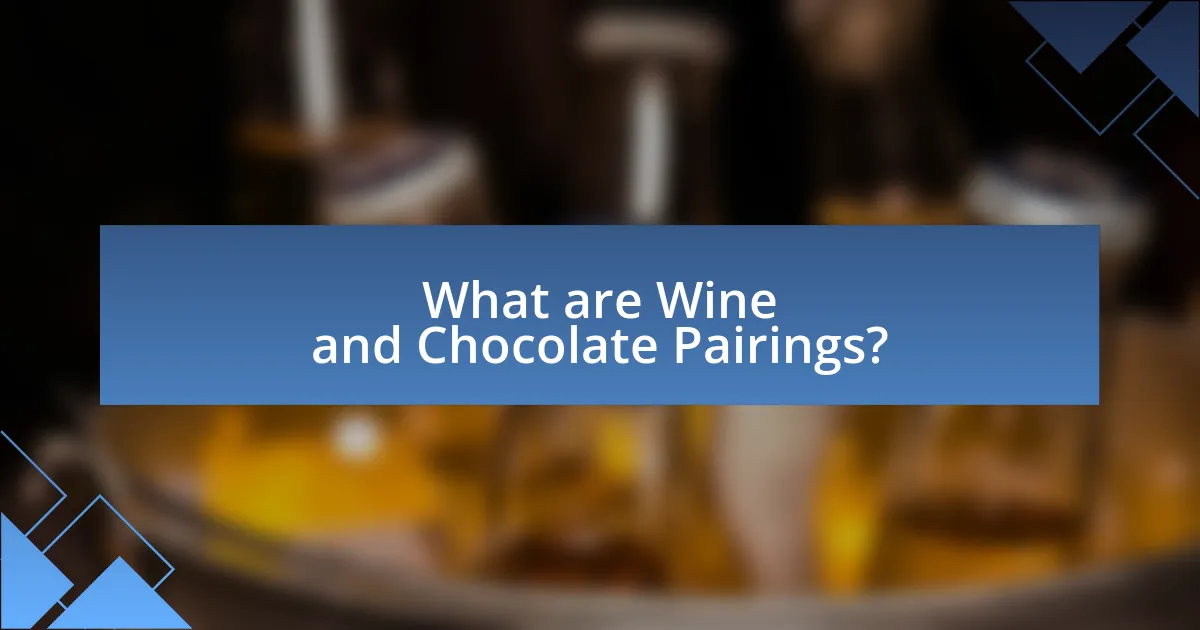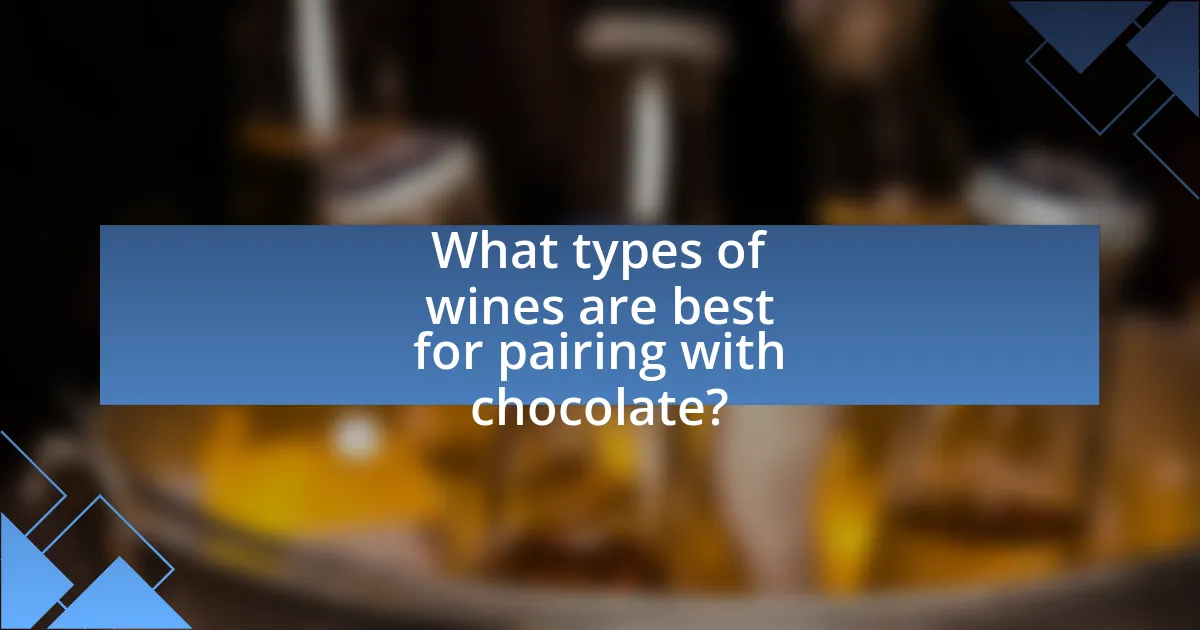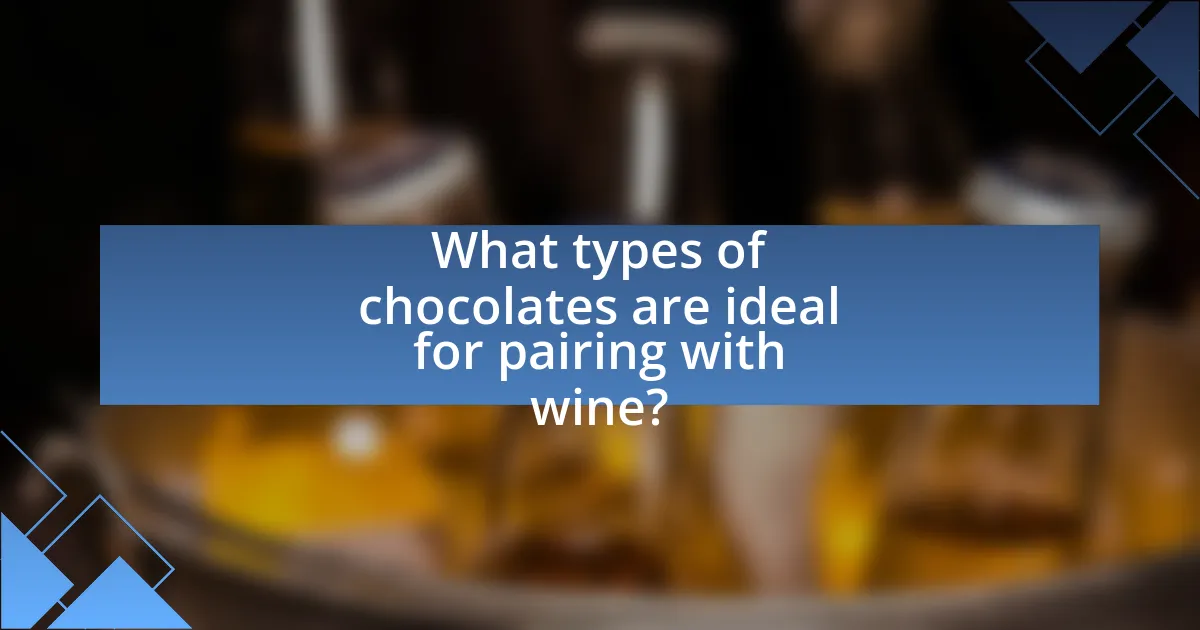Wine and chocolate pairings are combinations designed to enhance the flavors of both indulgences, based on complementary taste profiles such as sweetness, bitterness, and acidity. The article explores how these pairings work, highlighting the importance of flavor profiles, texture, and aroma in creating a luxurious tasting experience. It discusses the types of wines and chocolates that pair well together, including specific recommendations for red and white wines, as well as dessert wines. Additionally, the article addresses common mistakes in pairings, best practices for serving, and the cultural significance of wine and chocolate pairings in enhancing special occasions.

What are Wine and Chocolate Pairings?
Wine and chocolate pairings are combinations of specific wines and chocolates that enhance the flavors of both. These pairings are based on the complementary taste profiles, such as the sweetness of chocolate balancing the acidity of wine or the richness of chocolate matching the body of the wine. For example, dark chocolate often pairs well with robust red wines like Cabernet Sauvignon, as the tannins in the wine can soften the bitterness of the chocolate. Studies have shown that the right pairings can elevate the tasting experience, making it more enjoyable and complex.
How do wine and chocolate complement each other?
Wine and chocolate complement each other through their shared flavor profiles and contrasting textures, enhancing the tasting experience. The richness of chocolate, particularly dark chocolate, pairs well with the tannins in red wine, creating a balance that highlights the fruity and earthy notes in both. For example, a Cabernet Sauvignon’s bold flavors can elevate the deep cocoa notes in dark chocolate, while a sweet dessert wine like Port can enhance the sweetness of milk chocolate. This synergy is supported by sensory studies indicating that the combination of these two indulgences can create a more complex and enjoyable flavor experience for consumers.
What flavor profiles should be considered in pairings?
In wine and chocolate pairings, the primary flavor profiles to consider include sweetness, bitterness, acidity, and fruitiness. Sweetness in chocolate can complement the sweetness in dessert wines, while the bitterness of dark chocolate can balance the acidity found in certain red wines. Additionally, fruity notes in both wine and chocolate can enhance the overall tasting experience, creating a harmonious blend. For example, a rich dark chocolate with berry notes pairs well with a fruity Pinot Noir, as both share similar flavor characteristics, enhancing the tasting experience.
How do texture and aroma influence the tasting experience?
Texture and aroma significantly influence the tasting experience by affecting how flavors are perceived and enjoyed. Texture, such as creaminess or crispness, alters the mouthfeel and can enhance or diminish the overall flavor profile of a wine or chocolate pairing. For instance, a velvety chocolate can complement a smooth red wine, creating a harmonious experience. Aroma plays a crucial role as well; it contributes to the overall flavor perception, with studies indicating that up to 80% of taste is derived from smell. The aromatic compounds in both wine and chocolate can evoke specific flavors, enhancing the tasting experience. For example, fruity notes in wine can be accentuated by the rich aroma of dark chocolate, leading to a more complex and enjoyable tasting experience.
Why are wine and chocolate pairings considered luxurious?
Wine and chocolate pairings are considered luxurious due to their rich flavors and the sensory experience they provide. The combination of high-quality wines and artisanal chocolates creates a sophisticated tasting experience that appeals to the palate and enhances the enjoyment of both products. This pairing is often associated with fine dining and special occasions, elevating its status as a luxury experience. Additionally, the meticulous craftsmanship involved in producing premium wines and chocolates contributes to their perception as indulgent and exclusive, making them a favored choice for celebrations and gourmet events.
What cultural significance do these pairings hold?
Wine and chocolate pairings hold significant cultural importance as they symbolize indulgence, celebration, and the fusion of flavors across various culinary traditions. These pairings often represent a shared experience, enhancing social gatherings and special occasions, such as weddings and holidays. Historically, both wine and chocolate have been associated with luxury and refinement; for instance, chocolate was once a beverage of the elite in Mesoamerican cultures, while wine has been integral to European dining customs for centuries. The combination of these two elements reflects a sophisticated palate and an appreciation for artisanal craftsmanship, as seen in the growing trend of pairing fine wines with gourmet chocolates in culinary events and tastings.
How do wine and chocolate pairings enhance special occasions?
Wine and chocolate pairings enhance special occasions by creating a multisensory experience that elevates the enjoyment of both elements. The combination of rich flavors and aromas from wine and chocolate stimulates the palate, fostering a sense of indulgence and celebration. Research indicates that pairing complementary flavors can enhance taste perception, making the overall experience more memorable. For instance, a study published in the Journal of Sensory Studies found that participants rated their enjoyment higher when tasting wine and chocolate together compared to tasting them separately. This synergy not only enhances the flavors but also encourages social interaction, making special occasions more enjoyable and meaningful.

What types of wines are best for pairing with chocolate?
Red wines, particularly those with rich flavors like Cabernet Sauvignon, Merlot, and Zinfandel, are best for pairing with chocolate. These wines complement the sweetness and bitterness of chocolate, enhancing the overall tasting experience. For instance, Cabernet Sauvignon’s bold tannins and dark fruit notes harmonize well with dark chocolate, while Merlot’s softer profile pairs nicely with milk chocolate. Additionally, dessert wines such as Port and Madeira also work effectively, as their sweetness matches the richness of chocolate desserts. Studies have shown that the flavor compounds in these wines can elevate the chocolate’s taste, creating a luxurious pairing experience.
How do red wines differ from white wines in pairings?
Red wines differ from white wines in pairings primarily due to their tannin content and flavor profiles. Red wines, which typically have higher tannins, pair well with rich, fatty foods like red meats and aged cheeses, as the tannins help to soften the protein and enhance the flavors. In contrast, white wines, which are generally lighter and crisper, complement lighter dishes such as seafood, poultry, and salads, where their acidity can balance the flavors without overwhelming them. This distinction is supported by the principle that tannins in red wines can clash with delicate flavors, making them unsuitable for lighter fare, while the acidity in white wines can enhance the freshness of lighter dishes.
What specific red wines pair well with dark chocolate?
Cabernet Sauvignon, Merlot, and Zinfandel are specific red wines that pair well with dark chocolate. Cabernet Sauvignon’s bold tannins complement the richness of dark chocolate, while Merlot offers a softer, fruitier profile that enhances the chocolate’s flavors. Zinfandel, with its jammy fruit notes and spice, creates a harmonious balance with the bitterness of dark chocolate. These pairings are supported by the general principle that the wine’s body and flavor intensity should match the chocolate’s richness, enhancing the overall tasting experience.
Which white wines complement milk chocolate effectively?
White wines that effectively complement milk chocolate include Riesling, Chardonnay, and Moscato. Riesling, particularly those with a hint of sweetness, balances the creaminess of milk chocolate, enhancing its flavors. Chardonnay, especially when oaked, offers a rich texture and buttery notes that pair well with the smoothness of milk chocolate. Moscato, known for its sweetness and fruity profile, provides a refreshing contrast that elevates the chocolate experience. These pairings are supported by the general principle that sweeter wines tend to harmonize with sweeter desserts, making them ideal choices for milk chocolate.
What role do dessert wines play in chocolate pairings?
Dessert wines enhance chocolate pairings by complementing and balancing the rich flavors of chocolate. The sweetness and acidity of dessert wines, such as Sauternes or Port, create a harmonious contrast with the bitterness of dark chocolate, elevating the overall tasting experience. Studies indicate that the flavor profiles of dessert wines can accentuate the fruity or nutty notes in chocolate, making the combination more enjoyable. For instance, a study published in the Journal of Food Science highlights that pairing chocolate with sweet wines can enhance the perception of flavors, leading to a more luxurious tasting experience.
How do sweet wines enhance the flavors of chocolate?
Sweet wines enhance the flavors of chocolate by complementing its richness and balancing its bitterness. The high sugar content in sweet wines, such as Port or Sauternes, interacts with the cocoa’s natural flavors, creating a harmonious taste experience. This pairing works because the sweetness of the wine counteracts the bitterness of dark chocolate, while the wine’s fruity notes can elevate the chocolate’s complex flavor profile. Studies have shown that the right sweet wine can amplify the perception of flavors in chocolate, making the tasting experience more enjoyable and nuanced.
What are some popular dessert wines for chocolate pairings?
Some popular dessert wines for chocolate pairings include Port, Madeira, and Banyuls. Port, particularly Ruby Port, complements dark chocolate due to its rich, fruity flavors and sweetness. Madeira, with its nutty and caramel notes, pairs well with chocolate desserts that have a similar complexity. Banyuls, a fortified wine from the Roussillon region of France, is known for its chocolatey undertones, making it an excellent match for chocolate-based dishes. These wines enhance the tasting experience by balancing the sweetness and richness of chocolate.

What types of chocolates are ideal for pairing with wine?
Dark chocolate is ideal for pairing with red wines, particularly full-bodied varieties like Cabernet Sauvignon and Merlot. The rich, intense flavors of dark chocolate complement the tannins and fruit notes in these wines, creating a harmonious balance. Milk chocolate pairs well with lighter wines such as Pinot Noir or Riesling, as its creaminess enhances the wine’s fruitiness without overpowering it. White chocolate, being sweeter and creamier, is best matched with dessert wines like Moscato or Sauternes, which can counterbalance its sweetness. These pairings are supported by the principle that the flavor profiles of chocolate and wine can enhance each other, leading to a more enjoyable tasting experience.
How does the cocoa content affect pairing choices?
Cocoa content significantly influences pairing choices by determining the flavor intensity and bitterness of chocolate. Higher cocoa content, typically above 70%, results in a more robust and less sweet chocolate, which pairs well with full-bodied red wines like Cabernet Sauvignon or bold dessert wines such as Port. Conversely, chocolates with lower cocoa content, around 50% or less, tend to be sweeter and creamier, making them suitable for pairing with lighter wines like Riesling or sparkling wines, which can balance the sweetness. This pairing strategy is supported by sensory analysis studies that show how flavor profiles interact, enhancing the overall tasting experience.
What are the best pairings for high cocoa dark chocolate?
The best pairings for high cocoa dark chocolate include red wines, particularly Cabernet Sauvignon and Merlot, as their tannins complement the chocolate’s bitterness. Additionally, pairing with fruits like raspberries and oranges enhances the chocolate’s rich flavors, while nuts such as almonds and hazelnuts provide a satisfying crunch and contrast. These pairings are supported by the fact that the acidity in red wines balances the chocolate’s intensity, and the natural sweetness of fruits can elevate the tasting experience.
How do flavored chocolates change the pairing dynamics?
Flavored chocolates alter pairing dynamics by introducing distinct taste profiles that can complement or contrast with various wines. For instance, a chocolate infused with orange zest may enhance the citrus notes in a Sauvignon Blanc, while a chili-flavored chocolate can create a spicy interplay with a bold Zinfandel. This complexity allows for a broader range of flavor interactions, making the tasting experience more nuanced. Research indicates that specific flavor combinations can elevate the overall sensory experience, as seen in studies that explore how flavor compounds interact with wine tannins and acidity, thereby influencing the perception of both the chocolate and the wine.
What are some common mistakes in wine and chocolate pairings?
Common mistakes in wine and chocolate pairings include mismatching sweetness levels, overlooking flavor profiles, and ignoring texture compatibility. For instance, pairing a sweet dessert wine with a bitter dark chocolate can lead to an unbalanced experience, as the wine’s sweetness may not complement the chocolate’s bitterness. Additionally, failing to consider the flavor notes, such as pairing a fruity wine with a chocolate that has strong nutty or spicy flavors, can result in a clash rather than a harmonious blend. Lastly, neglecting the texture, such as pairing a heavy, tannic red wine with a light, airy chocolate, can create an unsatisfactory mouthfeel. These mistakes can diminish the overall tasting experience, highlighting the importance of thoughtful pairing.
How can one avoid overpowering flavors in pairings?
To avoid overpowering flavors in pairings, one should select complementary profiles that balance intensity. For instance, pairing a robust red wine with a dark chocolate that has a similar intensity can create harmony, while a lighter wine with a milder chocolate can prevent one flavor from overshadowing the other. Research indicates that flavor compounds in both wine and chocolate interact, and matching their intensity levels can enhance the tasting experience without dominance.
What should be considered when selecting wine and chocolate together?
When selecting wine and chocolate together, consider the flavor profiles and intensities of both. The wine’s sweetness, acidity, and tannins should complement the chocolate’s cocoa content and flavor notes. For example, a rich dark chocolate pairs well with a bold red wine like Cabernet Sauvignon, while a lighter milk chocolate may be better suited to a sweeter wine like Port. This pairing strategy is supported by the principle that complementary flavors enhance the tasting experience, as noted in studies on sensory perception in food and beverage pairings.
What tips can enhance the wine and chocolate tasting experience?
To enhance the wine and chocolate tasting experience, select complementary pairings that balance flavors, such as dark chocolate with robust red wines like Cabernet Sauvignon. This pairing works because the tannins in the wine soften the bitterness of the chocolate, creating a harmonious taste. Additionally, serve the wine at the appropriate temperature; red wines should be slightly below room temperature, while white wines are best chilled. This temperature control allows the full range of flavors to be appreciated. Lastly, encourage participants to savor each bite and sip slowly, as this mindfulness enhances the sensory experience and allows for a deeper appreciation of the complex flavors in both the wine and chocolate.
How should one prepare for a wine and chocolate tasting event?
To prepare for a wine and chocolate tasting event, one should select complementary wine and chocolate pairings that enhance each other’s flavors. Research indicates that certain wines, such as Cabernet Sauvignon, pair well with dark chocolate due to their rich, bold profiles, while lighter wines like Riesling complement milk chocolate’s sweetness. Additionally, participants should consider the order of tasting, starting with lighter wines and chocolates before progressing to heavier varieties, as this approach preserves palate sensitivity. Proper glassware and serving temperatures are also essential; red wines should be served slightly below room temperature, while white wines are best chilled. This preparation ensures an enjoyable and harmonious tasting experience.
What are the best practices for serving wine and chocolate together?
The best practices for serving wine and chocolate together include selecting complementary flavors, serving at the right temperature, and using appropriate portion sizes. Pairing dark chocolate with full-bodied red wines, such as Cabernet Sauvignon, enhances the rich flavors, while lighter chocolates, like white chocolate, pair well with sweeter wines, such as Moscato. Serving wine slightly chilled and chocolate at room temperature allows the flavors to fully develop. Additionally, offering small portions of chocolate alongside wine prevents overwhelming the palate, ensuring a balanced tasting experience. These practices are supported by the principles of flavor pairing, which emphasize the importance of matching intensity and sweetness levels for optimal enjoyment.


